Are you looking for an easy and nutritious addition to your meals? Look no further than mustard microgreens!
Growing mustard microgreens is simple and can be done in the comfort of your own home. With a few basic supplies and some patience, you can enjoy a continuous supply of these tasty greens in just a few weeks.
In this article, we’ll cover all the basics of growing microgreen seeds, including the health uses, the equipment you’ll need, and step-by-step instructions for a successful harvest and fruitful micro garden.
Let’s get started!
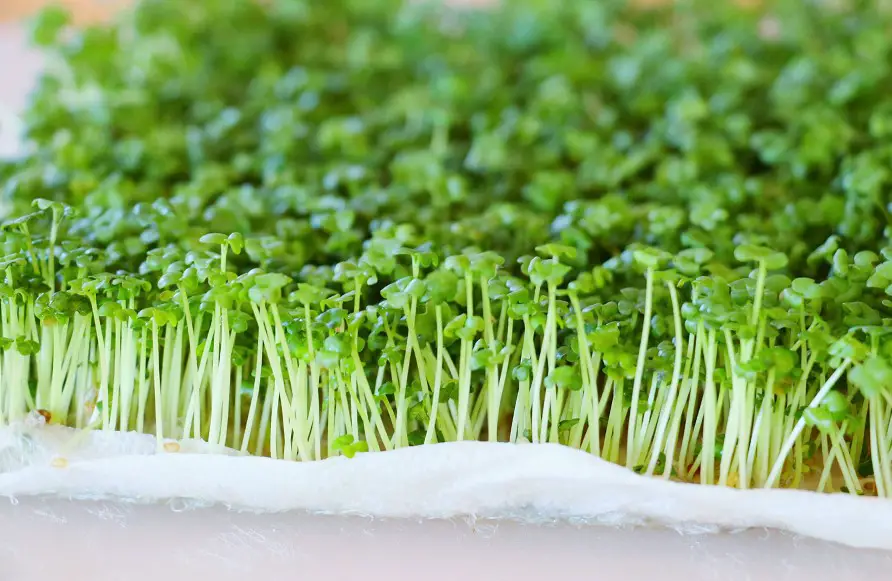
Contents
What are mustard microgreens?
Mustard microgreens are the young seedlings of the mustard plant that are harvested when they are only a few inches tall, about 10-14 days after planting.
These tiny plants have a sharp, peppery taste that can be used to enhance a wide range of dishes.
They are easy to grow and can be cultivated indoors or outdoors.
Red garnet mustard is a popular variety for micro greens due to its spicy flavors and beautiful red stems.
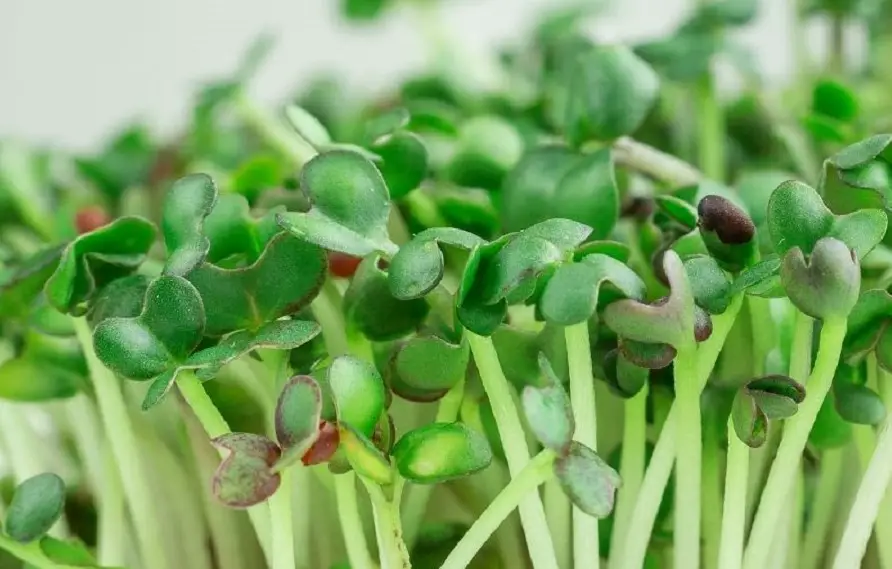
Can mustard microgreens be grown indoors?
Mustard microgreens can be easily grown indoors, making them an ideal choice for urban gardeners or those with limited space.
When growing microgreen seeds indoors, you can control the environment to ensure optimal growth conditions. They can be grown in a variety of containers such as trays, pots, or even mason jars.
Growing Red Garnet Mustard microgreen seeds indoors is a convenient and cost-effective way to add fresh, nutrient-dense greens to your diet.
These microgreens are packed with vitamins and minerals, and they are an excellent source of antioxidants.
Why grow mustard microgreens?
Growing these microgreens offers a range of benefits and there are a lot of mustard varieties. For starters, they’re easy to grow, making them a perfect choice for beginners.
They also grow quickly, taking only a few days to germinate and a couple of weeks to gather. Additionally, mustard microgreens are incredibly versatile and can be used in a variety of dishes, from salads to soups and stir-fries.
They have a tangy and spicy taste that adds depth and complexity to any meal. Best of all, they’re packed with nutrients, making them a great addition to any diet.
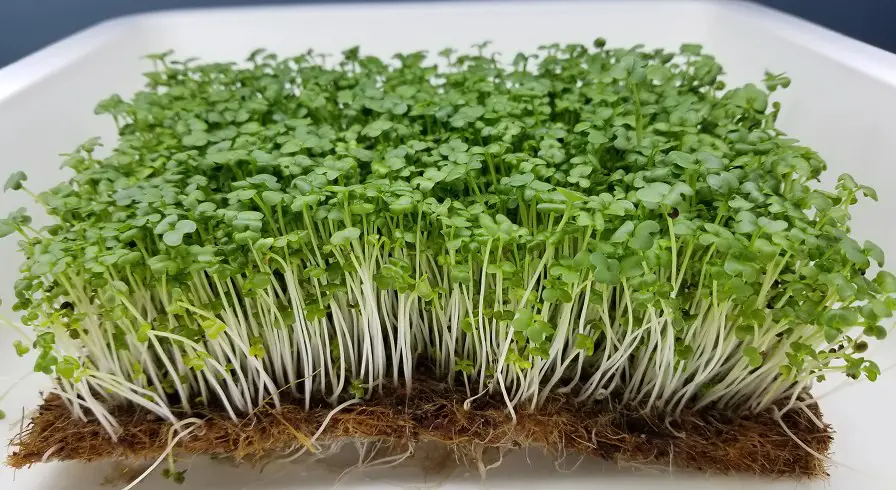
Nutritional benefits
Red Garnet Mustard microgreens are a great source of essential vitamins and minerals. They’re particularly high in vitamin C, which is important for immune function, wound healing, and collagen synthesis.
They also contain vitamin A, which is important for eye health and skin health, and vitamin K, which is important for bone health and blood clotting.
In addition, they’re a good source of dietary fiber, which can help regulate digestion and prevent constipation.
Mustard microgreens are also high in antioxidants, which can help protect against oxidative stress and reduce the risk of chronic diseases like cancer, heart disease, and diabetes.

Health benefits
In addition to their nutritional benefits, mustard microgreens offer a range of health benefits. For example, they may help reduce inflammation in the body, which is a common underlying factor in many chronic diseases.
They may also help regulate blood sugar levels, which is important for people with diabetes. In addition, mustard microgreens may help lower cholesterol levels, which is important for heart health.
They may even have antibacterial and antifungal properties, which can help protect against infections.

Growing mustard microgreens
Growing microgreens is a relatively simple process that requires minimal effort and time. To start, one needs to gather the necessary materials, including growing trays, potting soil, mustard seeds, and a spray bottle.
To grow mustard microgreens successfully, one must ensure that the environment is optimal for growth.
This includes keeping the growing trays in a warm and well-lit area, preferably near a window with more light or under a grow light.
Special equipment to grow mustard microgreens seeds
When it comes to special equipment for growing mustard seedlings, there are several options available.
One popular choice is a hydroponic growing system, which uses water instead of soil to grow the microgreens. Hydroponic systems are easy to use and are ideal for those who want to grow microgreens indoors.
Another option is to use a grow light to provide the necessary light for the microgreens to grow. Grow lights are especially useful during the winter months when natural light is limited.
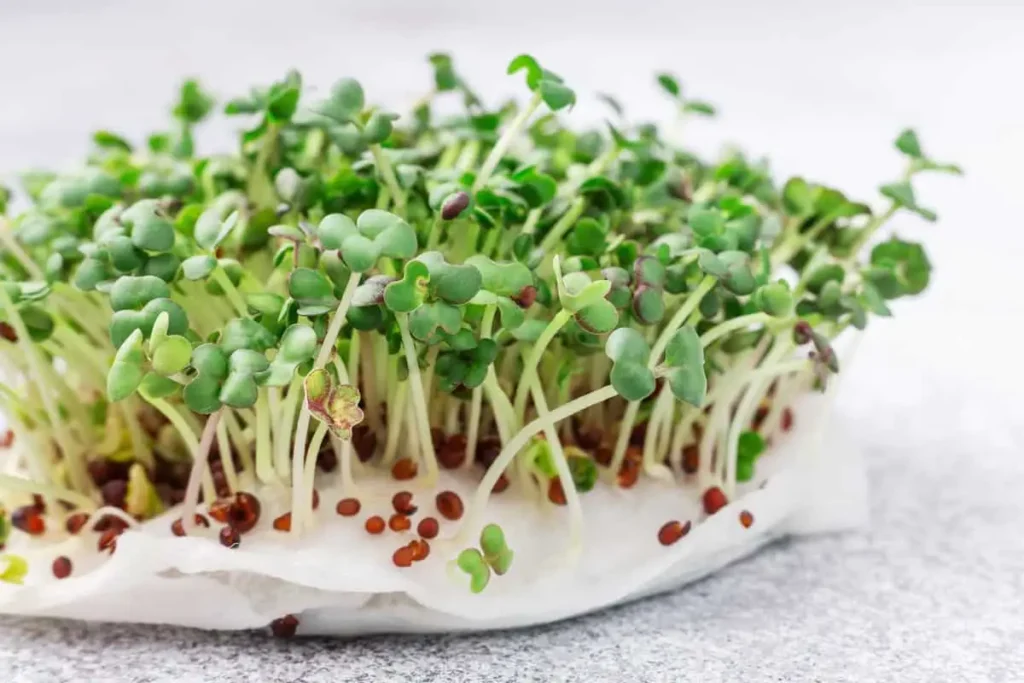
Choosing mustard seeds
To grow microgreens and build a healthy micro garden, it is important to choose the right type of mustard seed. There are different mustard varieties and seeds available, including black, brown, yellow, and red garnet mustard seeds.
However, yellow mustard seeds are the most commonly used to grow microgreens. When selecting mustard seeds for microgreens, it is essential to choose organic, non-GMO seeds from a reputable supplier.
Preparing the growing medium
Once you have selected the right type of mustard seeds, it’s time to prepare the growing medium. The growing medium is the material that the mustard seeds will grow.
The most commonly used growing mediums for a mustard microgreen are soil, coconut coir, or vermiculite.
It is important to ensure that the growing medium is free of any contaminants and that it provides proper drainage to seeds and prevents overwatering.
Before planting the seeds, it is crucial to moisten the growing medium adequately.
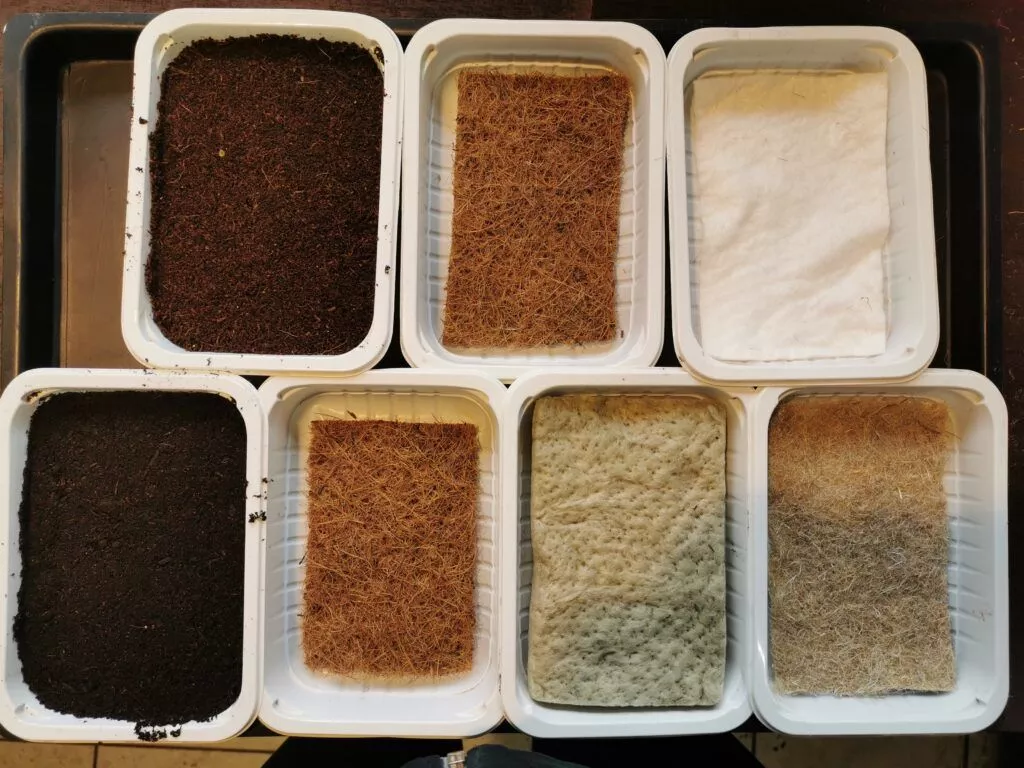
Planting the mustard seeds
After you have prepared the growing medium, it’s time to plant the mustard seeds. For growing microgreens, it is recommended to use a tray or container that has drainage holes.
Spread the microgreens seeds on top of the growing medium, making sure that they are evenly spaced.
It is best to plant mustard microgreen seeds densely to create a thick bed of microgreens.
The seeds should be covered with a thin layer of soil or growing medium to ensure that they stay moist.
Watering and lighting
To water, the mustard microgreen seeds, use a watering tray or a spray bottle with a fine nozzle to avoid disturbing the seeds.
A watering tray is especially useful to grow microgreens since the watering tray allows the plants to absorb water from the bottom, which promotes healthy root growth.
Red Garnet mustard microgreen seeds also require sufficient sunlight to grow. Place the watering tray or container in a well-lit area or under grow lights. It is recommended to use a timer to ensure that the microgreens get 12-16 hours of sunlight per day.
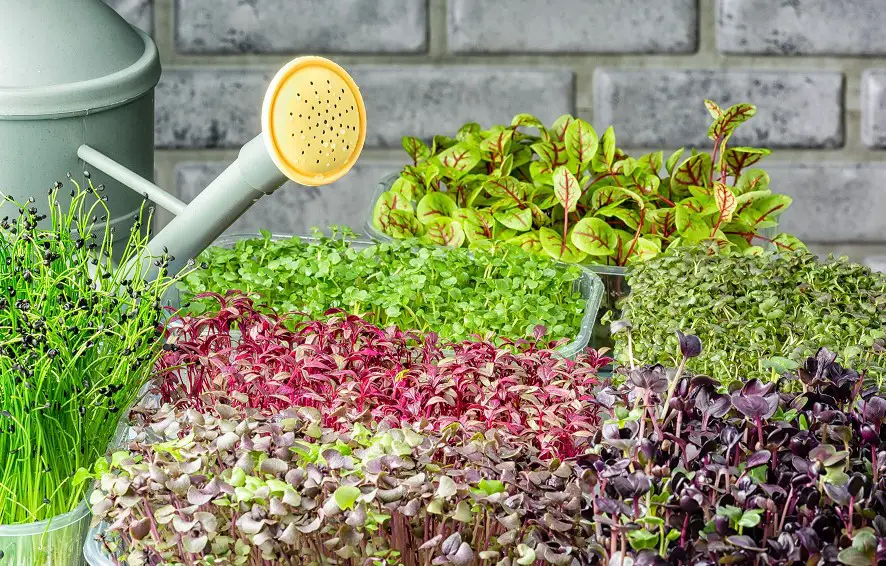
Harvesting
Harvesting mustard microgreens is an exciting process because it means you can finally enjoy the fruits of your labor.
The process of harvesting mustard microgreens is relatively simple and can be done in just a few steps. But before we dive into the process of harvesting, it’s essential to understand when to reap your mustard microgreens.
One of the most significant benefits of growing mustard greens is their short harvest window.
When is the best time to harvest?
The ideal time to gather your mustard microgreens is when they have grown to a height of about 1 to 2 inches. At this height, the leaves will be at their most tender and flavorful.
You can also wait for the cotyledons (the first leaves to appear) to fall off, which is a good indication that the microgreens are ready to be harvested.
How to harvest?
To reap the Red Garnet Mustard microgreens, start by watering the plants a few hours before you plan to gather them. This will help loosen the roots from the growing medium and make it easier to remove the microgreens.
Next, grab a pair of sharp scissors or a clean knife and start cutting the microgreens at the base of the stem.
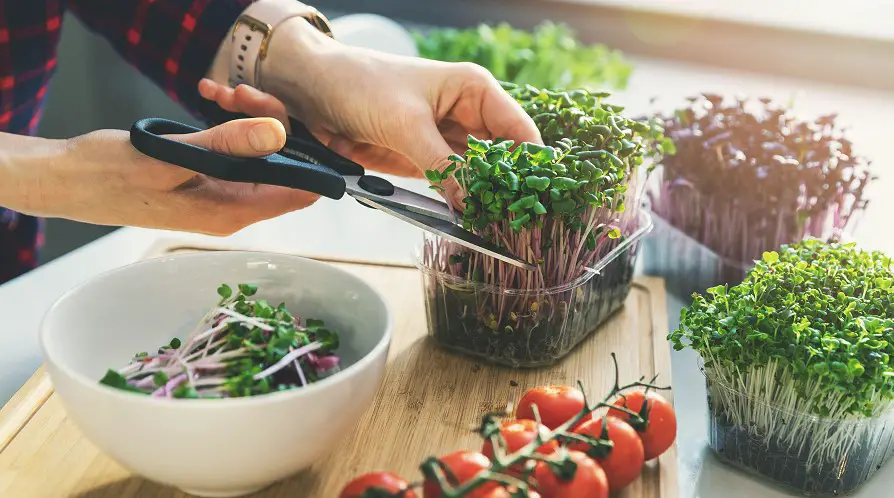
Mustard microgreens in the kitchen
There are countless ways to use mustard microgreens in the kitchen. These tiny greens can add a big punch of taste and nutrition to any dish.
How do you store harvested mustard microgreens?
Once you have reaped the mustard microgreens, it’s essential to store them properly to ensure they remain fresh and flavorful. You can store them in a sealed container in the refrigerator for up to a week, or you can enjoy them immediately.
Culinary uses
Red Garnet Mustard greens are versatile ingredients that can be used in a variety of culinary applications. These tender greens have a spicy, peppery taste that can add a unique kick to many dishes.
Some common uses for mustard micro greens include adding them to salads or using them as a garnish for soups and stews.
Recipes
One simple and delicious way to use mustard micro greens is to make fresh pesto. To make this sauce, combine mustard, garlic, Parmesan cheese, pine nuts, and olive oil in a food processor and blend until smooth.
This pesto can be used as a pasta sauce, a spread for pizza, or a dip for vegetables.

Mustard microgreens in the garden
Mustard microgreens are a fantastic addition to any garden or micro garden. They are easy to grow and can be great companion plantsfor other vegetables.
One of the most significant benefits of growing mustard microgreens is that they help to repel pests and diseases.
Companion planting
The natural compounds in mustard plants can act as a natural pesticide, and their presence in the garden can deter pests like aphids, nematodes, and cabbage worms.
Companion planting mustard microgreens alongside other plants like tomatoes, beans, or peppers can help to protect those plants from pests.
Pest and disease control
To prevent pests and diseases, it’s crucial to maintain proper care of the mustard microgreens. Proper watering and adequate lighting are essential to the growth and health of micro greens.
Overwatering can lead to mold growth, while underwatering can cause the plants to wilt and die. Additionally, it’s important to maintain the soil surface to keep the microgreens healthy.
One way to do this is by using a spray bottle to mist the soil instead of pouring water onto the plants.
Misting the soil will prevent the roots from getting damaged, and it will also promote the growth of root hairs, which are essential for absorbing nutrients from the soil.
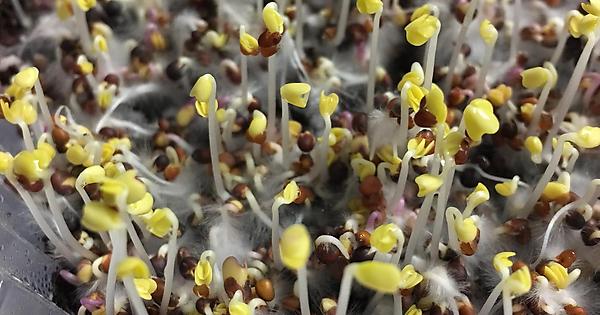
Common problems and troubleshooting
Growing red garnet mustard microgreens can be a rewarding experience, but there are common problems that can arise during the process.
One common issue is the growth of baby greens instead of microgreens. This can happen when the microgreen seeds are sown too thickly or when the growing medium is not well-draining.
To avoid this problem, it is important to use a high-quality potting mix and ensure that the soil surface is evenly moist for seeds.
Another issue that can occur is uneven growth, where some microgreens are larger than others.
This can be caused by inadequate lighting or improper watering.
To address this, it is recommended to use shallow trays and to place the seeds under a low-angle grow light to ensure that all microgreens receive equal amounts of light.
Some growers may encounter problems with mold or fungus growth, which can be caused by excessive moisture or poor ventilation.
To avoid this, it is important to provide proper air circulation and to avoid covering the microgreens with a plastic bag.
If mold or fungus growth does occur, it may be necessary to remove affected microgreens and discard them.
Finally, it is important to ensure that drainage holes are present in the growing containers to avoid water buildup, which can cause root rot. Additionally, it is important to monitor the mustard microgreen seeds closely and avoid a short harvest window.
By following these tips and troubleshooting common problems, growers can successfully cultivate healthy and flavorful red garnet mustard microgreens.

Tips and tricks for better harvest
When growing mustard microgreens, it’s also important to make sure that the growing environment is optimal. The microgreens need a warm place to grow and plenty of light.
Grow light is an excellent way to provide additional light for mustard plants, especially during the winter months when daylight hours are shorter.
Positioning the light at a lower angle can help to ensure that the microgreens receive more additional light, which will promote faster and healthier growth.
Choosing the right soil is also essential when growing mustard micro greens. A potting mix with adequate drainage holes is necessary to ensure proper drainage and prevent over-watering the seeds.
Some gardeners choose to use far less seed to prevent overcrowding and promote uniform growth.

FAQ
Can you eat mustard microgreens?
Yes, you can eat mustard microgreens. They are a great addition to many dishes, including salads, sandwiches, soups, and more.
Mustard micro greens are also great as a garnish, adding a pop of color and flavor to your favorite dishes.
What are the benefits of mustard microgreens?
Mustard micro greens are loaded with vitamins, minerals, and antioxidants. They are an excellent source of vitamin C, potassium, calcium, and iron, and are also high in dietary fiber.
Additionally, they contain compounds that have been shown to have anti-inflammatory and anti-cancer properties.
What do mustard microgreens taste like?
Mustard microgreens have a slightly spicy and tangy taste, similar to the flavors of mature mustard greens.
The intensity of the taste can vary depending on the variety of mustard microgreens you choose to grow. For example, red garnet mustard micro greens have a slightly sweeter and milder flavor than other varieties.
What are the benefits of yellow mustard microgreens?
Yellow mustard microgreens are a great source of nutrition, containing high levels of vitamins A, C, and K, as well as calcium and iron.
They also have a milder taste than some other varieties of mustard micro greens, making them a great choice for those who are new to microgreen gardening.
Conclusion
In conclusion, Red Garnet Mustard is a unique and flavorful variety of mustard microgreens that are easy to grow and packed with nutritional benefits.
These microgreens have a beautiful deep red color, adding a pop of color to any dish. When growing Red Garnet Mustard greens, it is important to use a well-draining soil mix, a shallow tray, and a watering pot to avoid waterlogging the seeds.
These microgreens can be used in a variety of culinary dishes, including salads and sandwiches.
Overall, Red Garnet Mustard microgreens are a healthy and delicious addition to any garden or kitchen.


